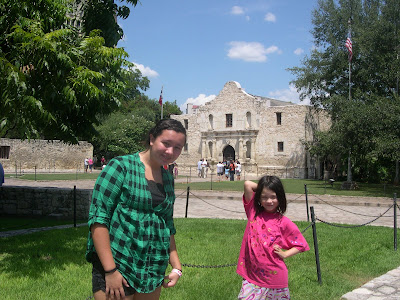Iconic San Antonio
We arrived in San Antonio on Friday the 13th and left Friday the 20th, traveling by way of that very Texas institution, Southwest Airlines. When we returned to suburban Chicago, her mother asked Lilly, "How was Texas?"
"Hot."
So it was, but in fact only five to 10 degrees (Fahrenheit) hotter than the Chicago area during the same span of days. Still, that made for a more oppressive heat, near or at 100° F. every day, which took some getting used to, even for me. Such is August in South Texas. Casual visitors, especially lifelong Yankees and Canadians, take note: see San Antonio in October or November or in March or April. Or during winter, for that matter, but take a coat. Hawaii, it's not. For the record, the climate is considered humid subtropical.
Hot or not, I spent a few afternoon hours last Wednesday introducing my daughters to some San Antonio icons. The Alamo, for example, which also counts as a Texas icon and, though out of fashion for now, an American icon. Maybe they'll read about the place later or see pictures of it, or even hear about its non-existent basement, but being there remains a different order of experience, so I took them.
A hot 'n' sweaty experience it was, until we entered the chapel of the Alamo, which has been air conditioned in our time (and has a roof, too, which it didn't have in 1836). Inside the quiet, somber space, we milled around with other people, looking at the various display cases, pieces of art and plaques, some of which are in small sacristy rooms off the main room. William Barrett Travis's ring and David Crockett's buckskin vest are among the items to be seen there.
According to the Moon Handbook of Texas, the Daughters of the Republic of Texas, who operate the shrine, "have removed from the north interior wall the large, tacky painting that featured Davy Crockett swinging his flintlock at a mob of Mexican soldiers -- the figure's face was unmistakably John Wayne's." Moon's usually pretty accurate, but I can't remember ever seeing such a painting, which sounds like the artwork for the 1960 movie Dmitri Tiomkin soundtrack. Then again, I've only visited the Alamo sporadically over the years, the last time being in 1993, I think. More poignant than any such painting are the names of the defenders on signs near the rear of the chapel, and the chipping of the walls that might date from the battle.
We passed a few good minutes in the chapel, and then a few less pleasant minutes in the gift shop, since Ann hasn't quite outgrown her little-kid pestering when it comes to retail spots. Outside the gift shop we returned to the hot 'n' sweaty experience, and it was all I could do to keep Lilly and Ann seated (in the shade -- still hot) to listen to a short talk about the siege of the Alamo by a costumed interpreter whose opinions on the subject I didn't entirely share, but who wasn't outrageously revisionist (along the lines of how dare those people not live up to modern standards).
We hurried through the Long Barracks at Lilly's insistence, even though that structure is also air conditioned and contains some fine exhibits. As it should, since the Long Barracks saw some of the fiercest fighting on the last day of the siege. Still, I managed to take a few more pictures of the grounds of the Alamo. Such as one of the enormous live oak (about 100 years old, it seems) shading the entrance to the Long Barracks, and a sizable cactus of indeterminate age near the chapel.
Who knows, maybe my daughters will actually remember the Alamo.
Labels: historic artifacts and sites, San Antonio, Texas, US history





1 Comments:
Any blog that references Dimitri Tiomkin is OK in my book.
Post a Comment
<< Home